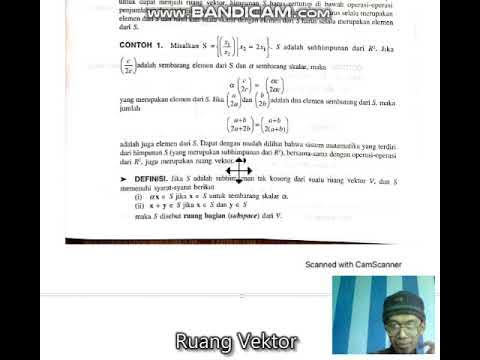Aula de Vetores - Parte I - G.A. e A. L.
Summary
TLDRIn this video, the instructor explains the concepts of linear dependence (LD) and linear independence (LI) using vector relationships. The discussion focuses on the conditions for vectors to be dependent or independent, including parallelism and coplanarity. The teacher walks through several examples to demonstrate how vectors can be expressed as linear combinations of others. Emphasis is placed on the importance of non-parallel vectors in forming a basis for a plane, and how these bases allow for the representation of any vector within the space. The video also covers orthogonal bases and their properties.
Takeaways
- 😀 The video explains the concept of linear dependence and independence of vectors, essential for understanding vector spaces.
- 😀 Three coplanar vectors can be described as linear combinations of each other, indicating they are linearly dependent.
- 😀 Two vectors are linearly dependent (LD) if they are parallel, meaning they have the same or opposite direction.
- 😀 Two vectors are linearly independent (LI) if they are not parallel, meaning they point in different directions.
- 😀 In a plane (R^2), if two vectors are not parallel and coplanar, they can form a basis for the space.
- 😀 A basis of a space consists of vectors that can represent any vector in that space as a linear combination of the basis vectors.
- 😀 To form a valid basis, vectors should not be parallel and should span the plane or space.
- 😀 If vectors are orthogonal (perpendicular to each other) and normalized (having a magnitude of 1), they form an orthonormal basis.
- 😀 The video provides examples showing how to express vectors as combinations of others, using appropriate scalars.
- 😀 The order of vectors in a basis is important when writing vectors as linear combinations; changing the order alters the representation.
- 😀 The concept of linear dependence and independence is fundamental for describing vector spaces and constructing bases for them.
Q & A
What is the main topic of the lesson discussed in the video?
-The main topic is linear dependence and independence of vectors, specifically focusing on the properties of coplanar vectors and how to describe vectors as linear combinations of others.
What does it mean for vectors to be 'coplanar'?
-Vectors are coplanar if they lie in the same plane. This means there is a single plane that contains all the vectors.
What is the significance of a vector being a linear combination of other vectors?
-If one vector can be written as a linear combination of others, it means that it lies within the span of those vectors and is dependent on them. This concept is key to understanding linear dependence and independence.
What does it mean for vectors to be linearly dependent (LD)?
-Vectors are linearly dependent if at least one of them can be written as a linear combination of the others, meaning that the vectors are not independent of each other and there is redundancy in their information.
How can you determine if two vectors are linearly independent (LI)?
-Two vectors are linearly independent if they are not parallel. This means they point in different directions and do not lie on the same line.
What is the criterion for a set of three vectors to be linearly dependent?
-A set of three vectors is linearly dependent if the vectors are coplanar, meaning they lie within the same plane.
What is a vector space basis and how is it related to linear independence?
-A basis for a vector space is a set of vectors that are linearly independent and can be combined to represent any other vector in that space. These vectors form a foundation for the space, allowing all other vectors to be expressed as linear combinations of the basis vectors.
What does it mean for a set of vectors to form an orthogonal basis?
-A set of vectors forms an orthogonal basis if the vectors are perpendicular (i.e., their dot product is zero) and have unit length (i.e., their norms are equal to 1). This creates a very efficient way to describe vectors in the space.
Can two parallel vectors form a basis for a plane?
-No, two parallel vectors cannot form a basis for a plane. For a valid basis, the vectors must be linearly independent, meaning they must not be parallel.
Why is the order of vectors important when writing a vector as a linear combination?
-The order of vectors is important because changing the order alters the coefficients of the linear combination. The coefficients correspond to specific scalars that multiply the respective vectors, and swapping them changes the resulting vector.
Outlines

このセクションは有料ユーザー限定です。 アクセスするには、アップグレードをお願いします。
今すぐアップグレードMindmap

このセクションは有料ユーザー限定です。 アクセスするには、アップグレードをお願いします。
今すぐアップグレードKeywords

このセクションは有料ユーザー限定です。 アクセスするには、アップグレードをお願いします。
今すぐアップグレードHighlights

このセクションは有料ユーザー限定です。 アクセスするには、アップグレードをお願いします。
今すぐアップグレードTranscripts

このセクションは有料ユーザー限定です。 アクセスするには、アップグレードをお願いします。
今すぐアップグレード関連動画をさらに表示

PPT Ruang Vektor Umum Rahmanadya Ayasha

SERI KULIAH ALJABAR LINEAR ELEMENTER || MEMBANGUN DAN BEBAS LINEAR

Linear combinations, span, and basis vectors | Chapter 2, Essence of linear algebra

Lecture 05 : Basis and Dimension

Lecture 2 || Vector Space II || Linear Algebra || IIT-JAM || CSIR NET || GATE || Vivek Sir

ALE Ruang Vektor 06a
5.0 / 5 (0 votes)
